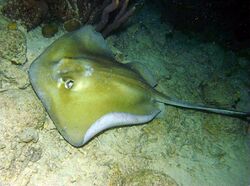Biology:Whiptail stingray
| Whiptail stingrays | |
|---|---|

| |
| Southern stingray (Dasyatis americana) | |
| Scientific classification | |
| Domain: | Eukaryota |
| Kingdom: | Animalia |
| Phylum: | Chordata |
| Class: | Chondrichthyes |
| Subclass: | Elasmobranchii |
| Superorder: | Batoidea |
| Order: | Myliobatiformes |
| Suborder: | Myliobatoidei |
| Superfamily: | Dasyatoidea |
| Family: | Dasyatidae D. S. Jordan, 1888 |
The whiptail stingrays are a family, the Dasyatidae, of rays in the order Myliobatiformes. They are found worldwide in tropical to temperate marine waters, and a number of species have also penetrated into fresh water in Africa, Asia, and Australia. Members of this family have flattened pectoral fin discs that range from oval to diamond-like in shape. Their common name comes from their whip-like tails, which are much longer than the disc and lack dorsal and caudal fins. All whiptail stingrays, except the porcupine ray (Urogymnus asperrimus), have one or more venomous stings near the base of the tail, which is used in defense. In order to sting their victims, they jerk their tails as the stinger falls off and stays in the wound that they have created. The stinger of a whiptail stingray is pointy, sharp with jagged edges. They range in size from 0.18 to 2.0 m (0.59 to 6.56 ft) or more across in the case of the smalleye stingray and giant freshwater stingray.
Genera
The taxonomy of Dasyatidae was revised by Peter Last, Gavin Naylor, and Mabel Manjaji-Matsumoto in 2016, based on morphological and molecular phylogenetic data. The placement of Megatrygon within the family is provisional pending further research, as evidence suggests it may be more closely related to the families Potamotrygonidae and Urotrygonidae than to other dasyatids.[2]
- Subfamily Dasyatinae
- Bathytoshia Whitley, 1933
- Dasyatis Rafinesque, 1810
- Hemitrygon Müller & Henle, 1838
- Hypanus Rafinesque, 1818
- Megatrygon Last, Naylor, and Manjaji-Matsumoto, 2016
- Pteroplatytrygon Fowler, 1910
- Telatrygon Last, Naylor, and Manjaji-Matsumoto, 2016
- Taeniurops Garman, 1913
- Subfamily Hypolophinae
- Makararaja T. R. Roberts, 2007
- Pastinachus Rüppell, 1829
- Subfamily Neotrygoninae
- Subfamily Urogymninae
- Brevitrygon Last, Naylor, and Manjaji-Matsumoto, 2016
- Fluvitrygon Last, Naylor, and Manjaji-Matsumoto, 2016
- Fontitrygon Last, Naylor, and Manjaji-Matsumoto, 2016
- Himantura J. P. Müller and Henle, 1837
- MaculabatisLast, Naylor, and Manjaji-Matsumoto, 2016
- Pateobatis Last, Naylor, and Manjaji-Matsumoto, 2016
- Urogymnus J. P. Müller and Henle, 1837
Phylogeny
| |||||||||||||||||||||||||||||||||||||||||||||||||||||||||||||||||||||||||||||||||||||||||||||||||||
| Phylogenetic relationships of dasyatid genera, based on mitochondrial DNA (Makararaja not included; Megatrygon does not cluster within the family).[2] |
See also
References
- ↑ "Phylogeography of the Indo-West Pacific maskrays (Dasyatidae, Neotrygon): a complex example of chondrichthyan radiation in the Cenozoic". Ecology and Evolution 3 (2): 217–232. 2012. doi:10.1002/ece3.448. PMID 23467194.
- ↑ 2.0 2.1 Last, P.R.; Naylor, G.J.; Manjaji-Matsumoto, B.M. (2016). "A revised classification of the family Dasyatidae (Chondrichthyes: Myliobatiformes) based on new morphological and molecular insights". Zootaxa 4139 (3): 345–368. doi:10.11646/zootaxa.4139.3.2. PMID 27470808.
Wikidata ☰ Q205678 entry
 |

